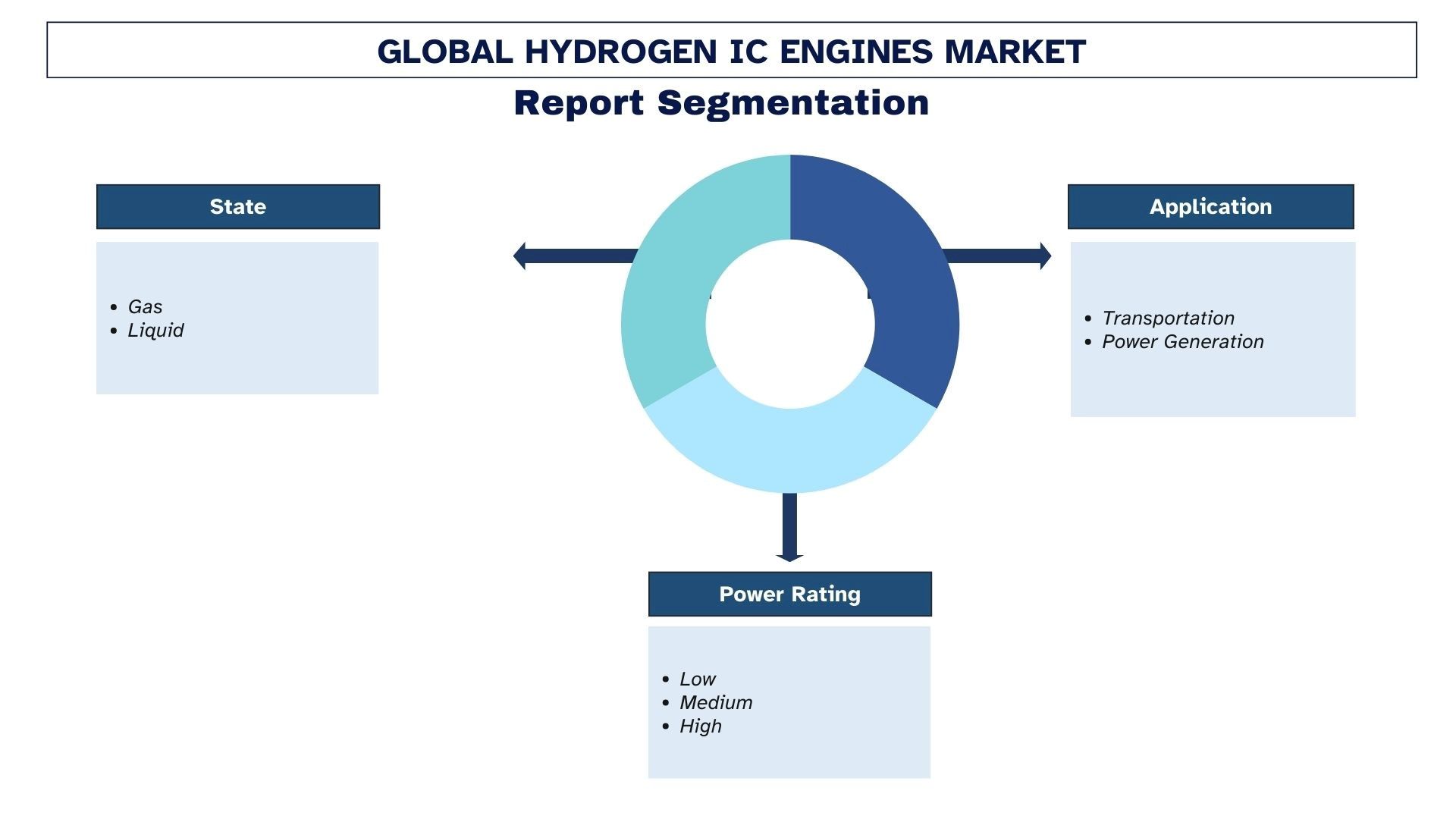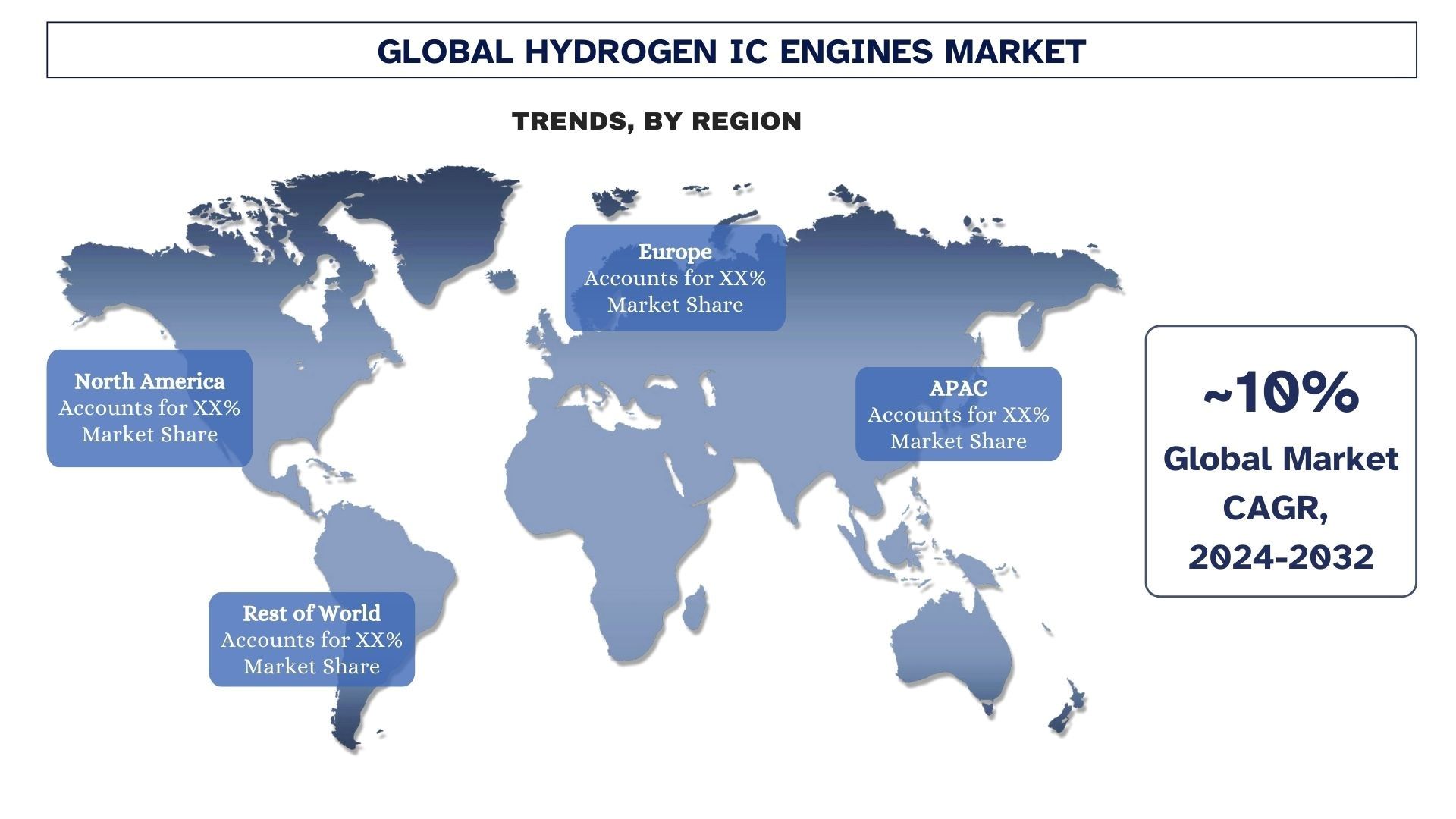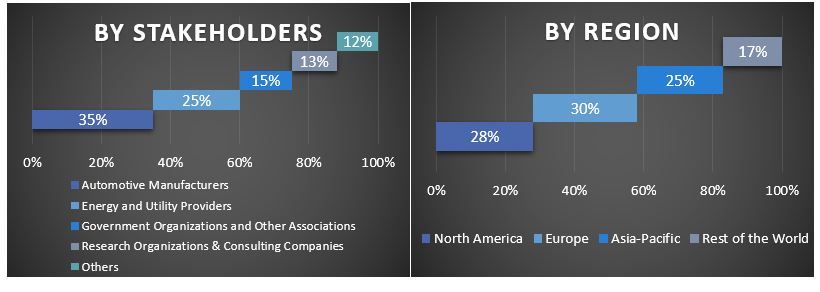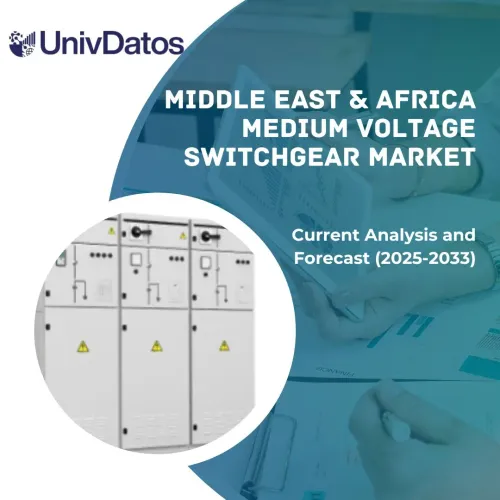- Inicio
- Acerca de nosotros
- Industria
- Servicios
- Leyendo
- Contáctenos
Mercado de motores de combustión interna de hidrógeno: análisis actual y previsión (2024-2032)
Énfasis en el Estado (Gas y Líquido); Aplicación (Transporte y Generación de Energía); Potencia Nominal (Baja, Media y Alta) y Región/País

Tamaño y previsión del mercado de motores de combustión interna de hidrógeno
El mercado de motores de combustión interna de hidrógeno se valoró en aproximadamente USD 12 mil millones en 2023 y se espera que crezca a una robusta CAGR de alrededor del 10% durante el período de pronóstico (2024-2032). El crecimiento del mercado de motores de combustión interna de hidrógeno está impulsado por la creciente demanda de soluciones de transporte ecológicas y los avances en la infraestructura de abastecimiento de hidrógeno.
Análisis del mercado de motores de combustión interna de hidrógeno
Un motor de combustión de hidrógeno es uno de los motores de combustión interna que utiliza hidrógeno como combustible principal. El hidrógeno se puede quemar en el motor como con gasolina o diésel, aunque con el beneficio adicional de que no hay emisiones de carbono, solo vapor. Esta conciencia ha sido impulsada por un mayor enfoque en la reducción de emisiones y la mejora de la sostenibilidad dentro de las industrias de transporte y fabricación. Los motores de combustión de hidrógeno se pueden adoptar en las industrias de transporte, generación de electricidad y maquinaria grande. Es probable que estos motores tengan aplicaciones vitales en industrias que están más allá del dominio de alcance de los vehículos eléctricos de batería, como camiones de larga distancia, aviones y buques de carga. Se espera que el uso de motores de hidrógeno para desarrollar soluciones de generación de energía contribuya al concepto de energía limpia al brindar la oportunidad de generar electricidad que no dependa de combustibles fósiles.
Se espera que la creciente demanda de energía limpia y el aumento del apoyo gubernamental hacia el hidrógeno en aplicaciones de combustión impulsen la utilización de la tecnología de motores de combustión de hidrógeno en los próximos años. El aumento de la demanda de inversiones en infraestructura de hidrógeno, la mejora en el diseño físico de los motores y su capacidad para soportar fuentes de energía renovables también influyen positivamente en la expansión del mercado en cuestión. Se espera que esta tecnología crezca aún más a medida que las organizaciones intenten alejarse de las fuentes tradicionales de combustibles fósiles.
Tendencias del mercado de motores de combustión interna de hidrógeno
Esta sección analiza las principales tendencias del mercado que influyen en los segmentos del mercado de motores de combustión interna de hidrógeno identificados por nuestros expertos en investigación.
El segmento de gas transforma la industria
El segmento de gas surgió como el segmento más grande en 2023. El hidrógeno líquido se usa menos debido a algunos desafíos experimentados al almacenarlo y manipularlo, además del reabastecimiento de combustible; el hidrógeno gaseoso, por otro lado, es más fácil de manejar, ya que no requiere estar en estado líquido y esto a temperaturas criogénicas. Los tanques de almacenamiento y las estaciones de servicio para hidrógeno gaseoso se han desarrollado significativamente hasta cierto punto en comparación con el hidrógeno líquido, y esta infraestructura respalda el uso de más vehículos ICE de hidrógeno. Además, el hidrógeno en forma gaseosa generalmente es más barato, ya que no requiere las soluciones de enfriamiento complejas que sí requiere el hidrógeno líquido. Esto lo convierte en una opción popular tanto para las industrias manufactureras como para los usuarios, especialmente a medida que la estructura del abastecimiento de combustible de hidrógeno sigue siendo dinámica. Pero en el futuro, con el desarrollo de nuevas tecnologías, el LH2 puede entrar en uso con mayor frecuencia en ciertas áreas específicas donde se necesita una alta densidad de energía.

Se espera que América del Norte domine el mercado durante el período de pronóstico
América del Norte domina el mercado de motores de combustión de hidrógeno y tiene el mayor porcentaje del segmento de mercado en la actualidad. Esto se debe a la expansión de la Investigación y Desarrollo que tiene como objetivo crear soluciones de alta innovación y satisfacer la demanda de los consumidores. Además, el gobierno de los Estados Unidos ha implementado programas para energías renovables para el desarrollo del mercado en toda la región. Los fabricantes de equipos originales (OEM) en los espacios no viales de los EE. UU. se están preparando para más llamados a una mayor descarbonización. Los gigantes mineros globales han establecido ambiciosos objetivos de descarbonización en los últimos dos años, apuntando a emisiones netas cero de Alcance 1 y 2. Además, 15 estados de EE. UU., incluido California, han adoptado requisitos adicionales que activan la producción de camiones eléctricos hasta el 30% para 2030. En función de estos factores, se prevé que aumente el tamaño del mercado de motores de combustión de hidrógeno. De hecho, los consumidores están prestando más atención a la aplicación de motores de combustión de hidrógeno debido a su versatilidad y a su versatilidad en diversos usos como combustible. Además, se prefieren porque también se pueden reducir al estado de gas o forma licuada para reducir los costos de transporte. Los actores clave están considerando reemplazarlo con hidrógeno azul o verde, lo que se espera que reduzca significativamente las emisiones de carbono.

Visión general de la industria de motores de combustión interna de hidrógeno
El mercado de motores de combustión interna de hidrógeno es competitivo, con varios actores del mercado globales e internacionales. Los actores clave están adoptando diferentes estrategias de crecimiento para mejorar su presencia en el mercado, como asociaciones, acuerdos, colaboraciones, lanzamientos de nuevos productos, expansiones geográficas y fusiones y adquisiciones. Algunos de los principales actores que operan en el mercado son Wärtsilä, Garrett Motion Inc., BeHydro, Deutz AG, Man Energy Solutions, Cummins Inc, Kawasaki Heavy Industries, Ltd, Toyota Motor Corporation, Mazda Motor Corporation y Reliance Industries Limited.
Desarrollo reciente:
Por ejemplo, en julio de 2024, el motor de hidrógeno de Triton EV marca un avance significativo en la tecnología automotriz. Utilizando hidrógeno como una fuente de combustible limpia y abundante, este innovador motor produce cero emisiones de carbono. A diferencia de los motores de gasolina tradicionales, que emiten dióxido de carbono y otros gases de efecto invernadero que contribuyen al calentamiento global.
Cobertura del informe del mercado de motores de combustión interna de hidrógeno
Atributo del informe | Detalles |
Año base | 2023 |
Periodo de previsión | 2024-2032 |
Impulso de crecimiento | Acelerar a una CAGR de 10% |
Tamaño del mercado 2023 | ~USD 12 mil millones |
Análisis regional | América del Norte, Europa, Asia-Pacífico, resto del mundo |
Principal región contribuyente | Se espera que Asia Pacífico crezca a la CAGR más alta durante el período previsto. |
Principales países cubiertos | EE. UU., Canadá, Alemania, Francia, Reino Unido, España, Italia, China, Japón e India |
Empresas perfiladas | Wärtsilä, Garrett Motion Inc., BeHydro, Deutz AG, Man Energy Solutions, Cummins Inc., Kawasaki Heavy Industries, Ltd, Toyota Motor Corporation, Mazda Motor Corporation y Reliance Industries Limited. |
Alcance del informe | Tendencias, impulsores y restricciones del mercado; Estimación y previsión de ingresos; Análisis de segmentación; Análisis de la demanda y la oferta; Panorama competitivo; Perfiles de empresa |
Segmentos cubiertos | Por estado, por aplicación, por clasificación de potencia, por región/país |
Razones para comprar este informe:
El estudio incluye un análisis de tamaño y previsión del mercado validado por expertos clave autenticados de la industria.
El informe presenta una revisión rápida del rendimiento general de la industria de un vistazo.
El informe cubre un análisis en profundidad de los pares prominentes de la industria con un enfoque principal en las finanzas comerciales clave, las carteras de productos, las estrategias de expansión y los desarrollos recientes.
Examen detallado de los impulsores, las restricciones, las tendencias clave y las oportunidades que prevalecen en la industria.
El estudio cubre de manera integral el mercado en diferentes segmentos.
Análisis profundo a nivel regional de la industria.
Opciones de personalización:
El mercado global de motores de combustión interna de hidrógeno se puede personalizar aún más según los requisitos o cualquier otro segmento de mercado. Además de esto, UMI entiende que puede tener sus propias necesidades comerciales; por lo tanto, no dude en comunicarse con nosotros para obtener un informe que se adapte completamente a sus requisitos.
Tabla de contenido
Metodología de Investigación para el Análisis del Mercado de Motores de Combustión Interna de Hidrógeno (2022-2032)
Analizar el mercado histórico, estimar el mercado actual y pronosticar el mercado futuro del mercado global de Motores de Combustión Interna de Hidrógeno fueron los tres pasos principales que se llevaron a cabo para crear y analizar la adopción de Motores de Combustión Interna de Hidrógeno en las principales regiones a nivel mundial. Se realizó una exhaustiva investigación secundaria para recopilar las cifras históricas del mercado y estimar el tamaño actual del mercado. En segundo lugar, se tomaron en consideración numerosos hallazgos y supuestos para validar estos conocimientos. Además, también se realizaron exhaustivas entrevistas primarias con expertos de la industria en toda la cadena de valor del mercado global de Motores de Combustión Interna de Hidrógeno. Tras la suposición y validación de las cifras del mercado a través de entrevistas primarias, empleamos un enfoque de arriba hacia abajo/de abajo hacia arriba para pronosticar el tamaño completo del mercado. Posteriormente, se adoptaron métodos de desglose del mercado y triangulación de datos para estimar y analizar el tamaño del mercado de los segmentos y subsegmentos de la industria. La metodología detallada se explica a continuación:
Análisis del Tamaño del Mercado Histórico
Paso 1: Estudio Profundo de Fuentes Secundarias:
Se llevó a cabo un estudio secundario detallado para obtener el tamaño del mercado histórico del mercado de Motores de Combustión Interna de Hidrógeno a través de fuentes internas de la empresa, como informes anuales y estados financieros, presentaciones de rendimiento, comunicados de prensa, etc., y fuentes externas que incluyen revistas, noticias y artículos, publicaciones gubernamentales, publicaciones de la competencia, informes del sector, bases de datos de terceros y otras publicaciones creíbles.
Paso 2: Segmentación del Mercado:
Después de obtener el tamaño del mercado histórico del mercado de motores de combustión interna de hidrógeno, realizamos un análisis secundario detallado para recopilar información histórica del mercado y compartirla para diferentes segmentos y subsegmentos para las principales regiones. Los principales segmentos se incluyen en el informe, como el estado, la aplicación, la potencia nominal y las regiones. Además, se realizaron análisis a nivel de país para evaluar la adopción general de modelos de prueba en esa región.
Paso 3: Análisis de Factores:
Después de adquirir el tamaño del mercado histórico de diferentes segmentos y subsegmentos, realizamos un análisis de factores detallado para estimar el tamaño actual del mercado de Motores de Combustión Interna de Hidrógeno. Además, realizamos un análisis de factores utilizando variables dependientes e independientes como el estado, la aplicación, la potencia nominal y las regiones del mercado de motores de combustión interna de hidrógeno. Se llevó a cabo un análisis exhaustivo de los escenarios de demanda y oferta teniendo en cuenta las principales asociaciones, fusiones y adquisiciones, expansión comercial y lanzamientos de productos en el sector del mercado de Motores de Combustión Interna de Hidrógeno en todo el mundo.
Estimación y Pronóstico del Tamaño del Mercado Actual
Tamaño Actual del Mercado: Basándonos en la información práctica de los tres pasos anteriores, llegamos al tamaño actual del mercado, los actores clave en el mercado global de Motores de Combustión Interna de Hidrógeno y las cuotas de mercado de los segmentos. Todos los porcentajes de participación requeridos y los desgloses del mercado se determinaron utilizando el enfoque secundario mencionado anteriormente y se verificaron a través de entrevistas primarias.
Estimación y Pronóstico: Para la estimación y el pronóstico del mercado, se asignaron ponderaciones a diferentes factores, incluidos los impulsores y las tendencias, las restricciones y las oportunidades disponibles para las partes interesadas. Después de analizar estos factores, se aplicaron técnicas de pronóstico relevantes, es decir, el enfoque de arriba hacia abajo/de abajo hacia arriba, para llegar al pronóstico del mercado para 2032 para diferentes segmentos y subsegmentos en los principales mercados a nivel mundial. La metodología de investigación adoptada para estimar el tamaño del mercado abarca:
El tamaño del mercado de la industria, en términos de ingresos (USD) y la tasa de adopción del mercado de motores de combustión interna de hidrógeno en los principales mercados a nivel nacional
Todos los porcentajes de participación, divisiones y desgloses de los segmentos y subsegmentos del mercado
Actores clave en el mercado global de motores de combustión interna de hidrógeno en términos de productos ofrecidos. Además, las estrategias de crecimiento adoptadas por estos actores para competir en el mercado de rápido crecimiento
Validación del Tamaño y la Cuota de Mercado
Investigación Primaria: Se realizaron entrevistas en profundidad con los Líderes de Opinión Clave (KOL), incluidos los Ejecutivos de Alto Nivel (CXO/VPs, Jefe de Ventas, Jefe de Marketing, Jefe de Operaciones, Jefe Regional, Jefe de País, etc.) en las principales regiones. Luego, se resumieron los hallazgos de la investigación primaria y se realizó un análisis estadístico para probar la hipótesis establecida. Los aportes de la investigación primaria se consolidaron con los hallazgos secundarios, convirtiendo así la información en conocimientos prácticos.
División de los Participantes Primarios en Diferentes Regiones

Ingeniería de Mercado
Se empleó la técnica de triangulación de datos para completar la estimación general del mercado y para llegar a números estadísticos precisos para cada segmento y subsegmento del mercado global de motores de combustión interna de hidrógeno. Los datos se dividieron en varios segmentos y subsegmentos después de estudiar varios parámetros y tendencias en el estado, la aplicación, la potencia nominal y las regiones del mercado global de Motores de Combustión Interna de Hidrógeno.
El objetivo principal del Estudio del Mercado Global de Motores de Combustión Interna de Hidrógeno
Las tendencias actuales y futuras del mercado global de motores de combustión interna de hidrógeno se identificaron en el estudio. Los inversores pueden obtener información estratégica para basar su discreción para las inversiones en el análisis cualitativo y cuantitativo realizado en el estudio. Las tendencias actuales y futuras del mercado determinaron el atractivo general del mercado a nivel regional, proporcionando una plataforma para que el participante industrial explote el mercado sin explotar para beneficiarse de una ventaja de ser el primero en actuar. Otros objetivos cuantitativos de los estudios incluyen:
Analizar el tamaño del mercado actual y pronosticado del mercado de Motores de Combustión Interna de Hidrógeno en términos de valor (USD). Además, analizar el tamaño del mercado actual y pronosticado de diferentes segmentos y subsegmentos.
Los segmentos en el estudio incluyen áreas de estado, aplicación, potencia nominal y regiones.
Definir y analizar el marco regulatorio para el Motor de Combustión Interna de Hidrógeno
Analizar la cadena de valor involucrada con la presencia de varios intermediarios, junto con el análisis del comportamiento de clientes y competidores de la industria.
Analizar el tamaño del mercado actual y pronosticado del mercado de Motores de Combustión Interna de Hidrógeno para la región principal.
Los principales países de las regiones estudiadas en el informe incluyen Asia Pacífico, Europa, América del Norte y el resto del mundo
Perfiles de empresas del mercado de Motores de Combustión Interna de Hidrógeno y las estrategias de crecimiento adoptadas por los participantes del mercado para mantenerse en el mercado de rápido crecimiento.
Análisis profundo a nivel regional de la industria
Preguntas frecuentes Preguntas frecuentes
P1: ¿Cuál es el tamaño actual y el potencial de crecimiento del mercado mundial de motores de combustión interna de hidrógeno?
El mercado global de motores de combustión interna de hidrógeno se valoró en USD 12 mil millones en 2023 y se espera que crezca a una CAGR del 10% durante el período de pronóstico (2024-2032).
P2: ¿Cuáles son los factores impulsores del crecimiento del mercado mundial de motores de combustión interna de hidrógeno?
El crecimiento del mercado de motores de combustión interna de hidrógeno está impulsado por la creciente demanda de soluciones de transporte ecológicas y los avances en la infraestructura de suministro de hidrógeno.
P3: ¿Qué segmento tiene la mayor cuota del mercado global de motores de combustión interna de hidrógeno por estado?
El segmento de gas tiene la mayor cuota de mercado de motores de combustión interna de hidrógeno por estado.
P4: ¿Cuáles son las tecnologías y tendencias emergentes en el mercado global de motores de combustión interna de hidrógeno?
Las tecnologías emergentes y las tendencias en el mercado global de motores de combustión interna de hidrógeno incluyen avances en los sistemas de inyección de combustible de hidrógeno, los motores de combustible dual y la integración de la IA para optimizar la eficiencia del combustible y el control de emisiones.
P5: ¿Qué región dominará el mercado mundial de motores de combustión interna de hidrógeno?
Se espera que Norteamérica domine el mercado en 2023.
Relacionados Informes
Los clientes que compraron este artículo también compraron










